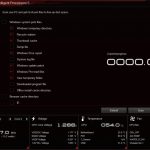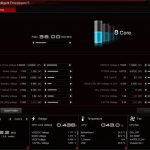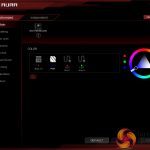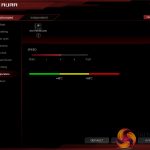Software
The OS software available for ASUS' X370 motherboard is very similar to the offerings available for the vendor's mainstream Intel motherboards (such as the STRIX Z270F Gaming). As such, our analysis follows a very similar tone.
To say that ASUS includes a dizzying amount of software with its motherboards would be an understatement. Thankfully, ASUS uses its AI Suite 3 tool to good effect in managing a large proportion of the software under a single umbrella (though not to the same level that Gigabyte does).
AI Suite 3 is the go-to point for any settings or information relating to system operations. Want to check temperatures and voltages or adjust multipliers for the CPU and speeds of fans? AI Suite 3. Want to speed up certain programs or reduce the amount of RAM-hogging operations on your system? AI Suite 3. Want to check for a BIOS update? AI Suite 3.
Automated system tuning conducted by the 5-way optimisation tool can also be selected inside AI Suite 3.
ASUS’ AURA RGB tool is a comprehensive piece of software used for managing the colours and operating parameters of onboard and connected LEDs. LED operating modes can be synchronised with other compatible hardware, such as ASUS graphics cards and even the AMD Wraith Spire CPU cooler, or managed for the motherboard alone.
I particularly like the CPU temperature mode that changes the light colour based on processor thermals. This is similar to one of the options in Gigabyte’s ‘intelligent’ RGB Fusion modes (though Gigabyte has additional modes available).
With that said, the layout of AURA is questionable. The colour choice is handled by an outer colour ring and then an inner triangle zone. The ring is meant to provide an estimated colour choice and the triangle allows fine-tuning of the desired colour. Fine in theory, but in practise this can result in the LEDs displaying colours that aren't close to what was chosen due to the inner triangle's bias for dark blacks or bright whites.
Mem TweakIT deals with information relating to DRAM frequency, timings, and a performance score.
As the name suggests, RAMDisk allows a pool of memory to be allocated as a speedy storage medium using DDR4 RAM.
RAMCache II can be used to allocate a user-chosen amount of RAM to be used as a write cache for transfers from external drives. This is particularly useful if you are transferring data from a fast external flash storage medium to an internal HDD. The pool of DDR4-based cache can be written to at the external drive's maximum transfer rate before being dumped onto the slower internal HDD even if the external device is removed.
More software utilities are available for download directly from ASUS.
OS Software Summary:
The sheer volume and quality of OS-based software that ASUS makes available is impressive. AI Suite 3 is home to the important system-related settings and does a good job at categorising several tools under one single umbrella suite rather than multiple individual shortcuts.
AURA is a solid tool that provides a good degree of RGB customisation in terms of colour and operating modes, provided you can manage the awkward layout of colour traingles. However, more flexibility with respect to ‘intelligent' lighting modes would be welcomed as this is an area where the likes of Gigabyte and NZXT perform well.
RAMCache II and RAMDisk are smart pieces of software that can help to make use of wasted system RAM and provide a speed boost in doing so.
Be sure to check out our sponsors store EKWB here
 KitGuru KitGuru.net – Tech News | Hardware News | Hardware Reviews | IOS | Mobile | Gaming | Graphics Cards
KitGuru KitGuru.net – Tech News | Hardware News | Hardware Reviews | IOS | Mobile | Gaming | Graphics Cards















